Analysis of Capital Budgeting Techniques in Southern Italian Firms
VerifiedAdded on 2022/10/12
|15
|6971
|3
Report
AI Summary
This report examines capital budgeting practices in Southern Italy, based on a survey of 71 firms. It reviews the importance of capital budgeting in financial management and explores techniques like Payback Period (PP), Net Present Value (NPV), and Internal Rate of Return (IRR). The study found that PP, followed by NPV, is the most used method, with more complex methods favored by larger enterprises. The research highlights the weakness in defining the cost of capital, as approximately 70% of firms use non-quantitative techniques for risk assessment. The study provides insights into common pitfalls in capital budgeting, offering valuable knowledge for those evaluating investment projects and developing capital budgeting policies. The research methodology included a survey of CFOs, and the findings are analyzed using descriptive approaches and chi-square tests. The report also discusses the influence of firm size and industry sector on capital budgeting choices, offering a foundation for further research in the field.

See discussions, stats, and author profiles for this publication at: https://www.researchgate.net/publication/277655349
The use of capital budgeting techniques: An outlook from Italy
Article in International Journal of Management Practice · January 2015
DOI: 10.1504/IJMP.2015.068302
CITATIONS
10
READS
5,147
1 author:
Some of the authors of this publication are also working on these related projects:
Venture CapitalView project
Indonesian Journal of Sustainability Accounting and ManagementView project
Matteo Rossi
Università degli Studi del Sannio
52PUBLICATIONS496CITATIONS
SEE PROFILE
All content following this page was uploaded by Matteo Rossi on 04 January 2016.
The user has requested enhancement of the downloaded file.
The use of capital budgeting techniques: An outlook from Italy
Article in International Journal of Management Practice · January 2015
DOI: 10.1504/IJMP.2015.068302
CITATIONS
10
READS
5,147
1 author:
Some of the authors of this publication are also working on these related projects:
Venture CapitalView project
Indonesian Journal of Sustainability Accounting and ManagementView project
Matteo Rossi
Università degli Studi del Sannio
52PUBLICATIONS496CITATIONS
SEE PROFILE
All content following this page was uploaded by Matteo Rossi on 04 January 2016.
The user has requested enhancement of the downloaded file.
Paraphrase This Document
Need a fresh take? Get an instant paraphrase of this document with our AI Paraphraser
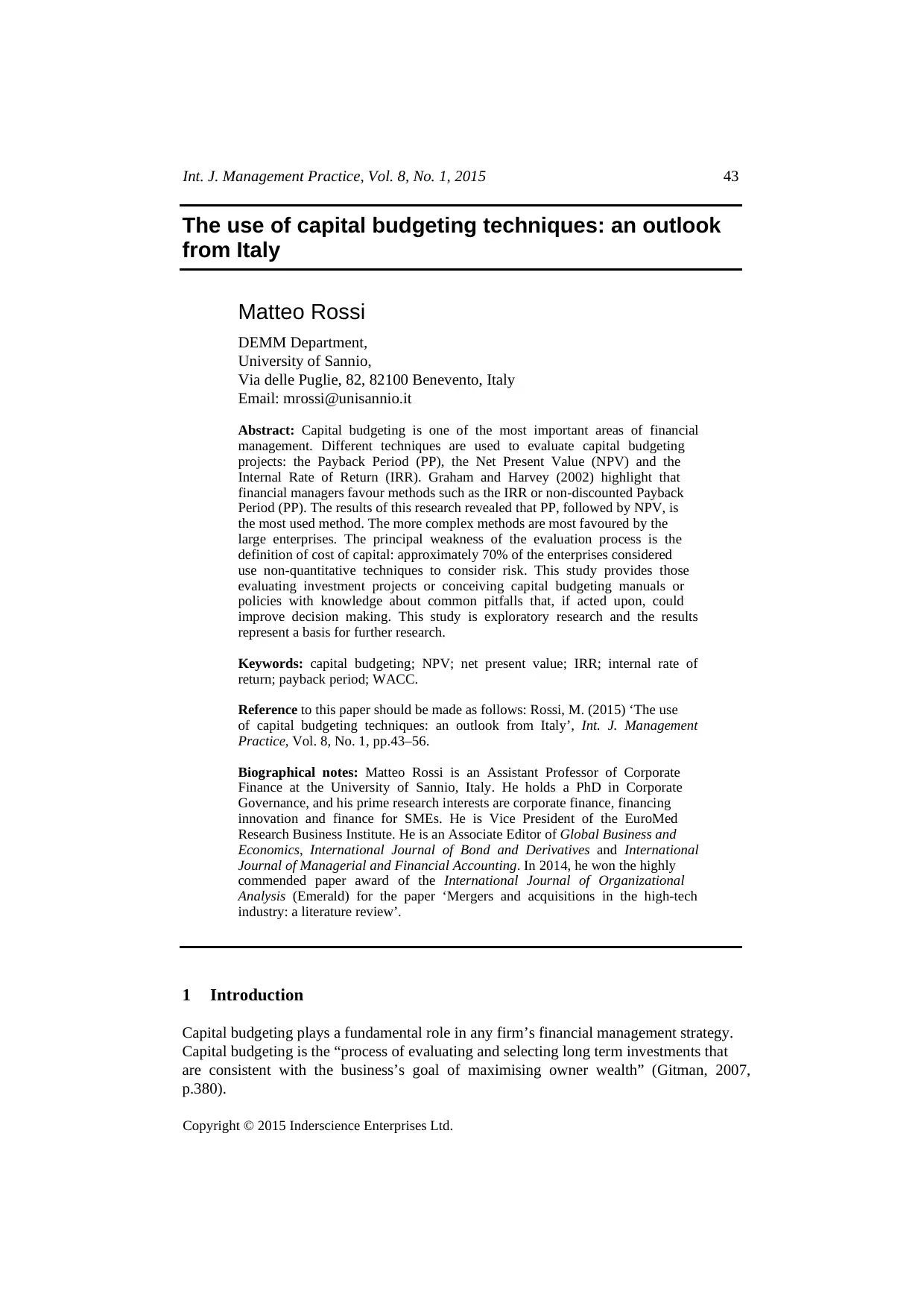
Int. J. Management Practice, Vol. 8, No. 1, 2015 43
Copyright © 2015 Inderscience Enterprises Ltd.
The use of capital budgeting techniques: an outlook
from Italy
Matteo Rossi
DEMM Department,
University of Sannio,
Via delle Puglie, 82, 82100 Benevento, Italy
Email: mrossi@unisannio.it
Abstract: Capital budgeting is one of the most important areas of financial
management. Different techniques are used to evaluate capital budgeting
projects: the Payback Period (PP), the Net Present Value (NPV) and the
Internal Rate of Return (IRR). Graham and Harvey (2002) highlight that
financial managers favour methods such as the IRR or non-discounted Payback
Period (PP). The results of this research revealed that PP, followed by NPV, is
the most used method. The more complex methods are most favoured by the
large enterprises. The principal weakness of the evaluation process is the
definition of cost of capital: approximately 70% of the enterprises considered
use non-quantitative techniques to consider risk. This study provides those
evaluating investment projects or conceiving capital budgeting manuals or
policies with knowledge about common pitfalls that, if acted upon, could
improve decision making. This study is exploratory research and the results
represent a basis for further research.
Keywords: capital budgeting; NPV; net present value; IRR; internal rate of
return; payback period; WACC.
Reference to this paper should be made as follows: Rossi, M. (2015) ‘The use
of capital budgeting techniques: an outlook from Italy’, Int. J. Management
Practice, Vol. 8, No. 1, pp.43–56.
Biographical notes: Matteo Rossi is an Assistant Professor of Corporate
Finance at the University of Sannio, Italy. He holds a PhD in Corporate
Governance, and his prime research interests are corporate finance, financing
innovation and finance for SMEs. He is Vice President of the EuroMed
Research Business Institute. He is an Associate Editor of Global Business and
Economics, International Journal of Bond and Derivatives and International
Journal of Managerial and Financial Accounting. In 2014, he won the highly
commended paper award of the International Journal of Organizational
Analysis (Emerald) for the paper ‘Mergers and acquisitions in the high-tech
industry: a literature review’.
1 Introduction
Capital budgeting plays a fundamental role in any firm’s financial management strategy.
Capital budgeting is the “process of evaluating and selecting long term investments that
are consistent with the business’s goal of maximising owner wealth” (Gitman, 2007,
p.380).
Copyright © 2015 Inderscience Enterprises Ltd.
The use of capital budgeting techniques: an outlook
from Italy
Matteo Rossi
DEMM Department,
University of Sannio,
Via delle Puglie, 82, 82100 Benevento, Italy
Email: mrossi@unisannio.it
Abstract: Capital budgeting is one of the most important areas of financial
management. Different techniques are used to evaluate capital budgeting
projects: the Payback Period (PP), the Net Present Value (NPV) and the
Internal Rate of Return (IRR). Graham and Harvey (2002) highlight that
financial managers favour methods such as the IRR or non-discounted Payback
Period (PP). The results of this research revealed that PP, followed by NPV, is
the most used method. The more complex methods are most favoured by the
large enterprises. The principal weakness of the evaluation process is the
definition of cost of capital: approximately 70% of the enterprises considered
use non-quantitative techniques to consider risk. This study provides those
evaluating investment projects or conceiving capital budgeting manuals or
policies with knowledge about common pitfalls that, if acted upon, could
improve decision making. This study is exploratory research and the results
represent a basis for further research.
Keywords: capital budgeting; NPV; net present value; IRR; internal rate of
return; payback period; WACC.
Reference to this paper should be made as follows: Rossi, M. (2015) ‘The use
of capital budgeting techniques: an outlook from Italy’, Int. J. Management
Practice, Vol. 8, No. 1, pp.43–56.
Biographical notes: Matteo Rossi is an Assistant Professor of Corporate
Finance at the University of Sannio, Italy. He holds a PhD in Corporate
Governance, and his prime research interests are corporate finance, financing
innovation and finance for SMEs. He is Vice President of the EuroMed
Research Business Institute. He is an Associate Editor of Global Business and
Economics, International Journal of Bond and Derivatives and International
Journal of Managerial and Financial Accounting. In 2014, he won the highly
commended paper award of the International Journal of Organizational
Analysis (Emerald) for the paper ‘Mergers and acquisitions in the high-tech
industry: a literature review’.
1 Introduction
Capital budgeting plays a fundamental role in any firm’s financial management strategy.
Capital budgeting is the “process of evaluating and selecting long term investments that
are consistent with the business’s goal of maximising owner wealth” (Gitman, 2007,
p.380).
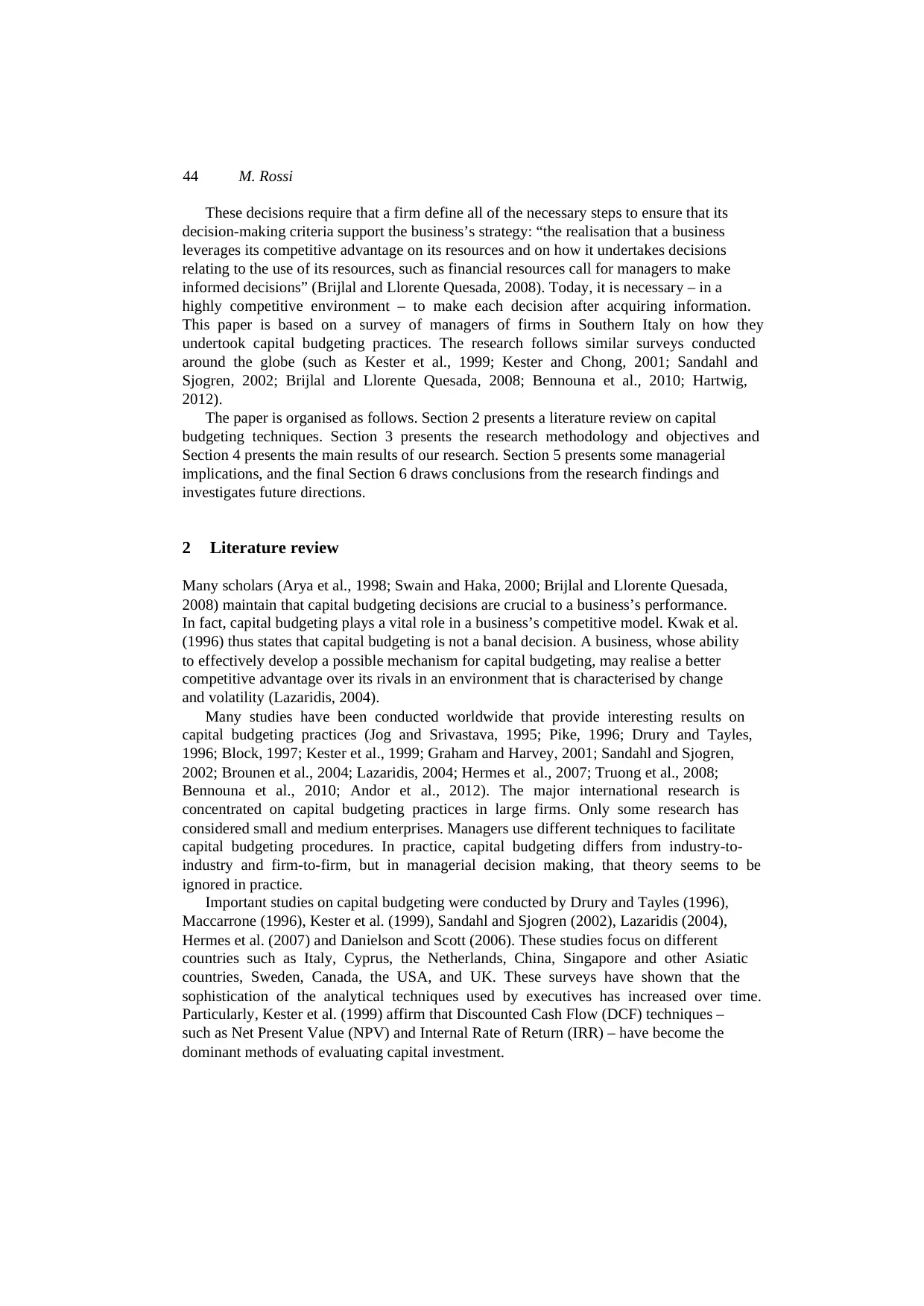
44 M. Rossi
These decisions require that a firm define all of the necessary steps to ensure that its
decision-making criteria support the business’s strategy: “the realisation that a business
leverages its competitive advantage on its resources and on how it undertakes decisions
relating to the use of its resources, such as financial resources call for managers to make
informed decisions” (Brijlal and Llorente Quesada, 2008). Today, it is necessary – in a
highly competitive environment – to make each decision after acquiring information.
This paper is based on a survey of managers of firms in Southern Italy on how they
undertook capital budgeting practices. The research follows similar surveys conducted
around the globe (such as Kester et al., 1999; Kester and Chong, 2001; Sandahl and
Sjogren, 2002; Brijlal and Llorente Quesada, 2008; Bennouna et al., 2010; Hartwig,
2012).
The paper is organised as follows. Section 2 presents a literature review on capital
budgeting techniques. Section 3 presents the research methodology and objectives and
Section 4 presents the main results of our research. Section 5 presents some managerial
implications, and the final Section 6 draws conclusions from the research findings and
investigates future directions.
2 Literature review
Many scholars (Arya et al., 1998; Swain and Haka, 2000; Brijlal and Llorente Quesada,
2008) maintain that capital budgeting decisions are crucial to a business’s performance.
In fact, capital budgeting plays a vital role in a business’s competitive model. Kwak et al.
(1996) thus states that capital budgeting is not a banal decision. A business, whose ability
to effectively develop a possible mechanism for capital budgeting, may realise a better
competitive advantage over its rivals in an environment that is characterised by change
and volatility (Lazaridis, 2004).
Many studies have been conducted worldwide that provide interesting results on
capital budgeting practices (Jog and Srivastava, 1995; Pike, 1996; Drury and Tayles,
1996; Block, 1997; Kester et al., 1999; Graham and Harvey, 2001; Sandahl and Sjogren,
2002; Brounen et al., 2004; Lazaridis, 2004; Hermes et al., 2007; Truong et al., 2008;
Bennouna et al., 2010; Andor et al., 2012). The major international research is
concentrated on capital budgeting practices in large firms. Only some research has
considered small and medium enterprises. Managers use different techniques to facilitate
capital budgeting procedures. In practice, capital budgeting differs from industry-to-
industry and firm-to-firm, but in managerial decision making, that theory seems to be
ignored in practice.
Important studies on capital budgeting were conducted by Drury and Tayles (1996),
Maccarrone (1996), Kester et al. (1999), Sandahl and Sjogren (2002), Lazaridis (2004),
Hermes et al. (2007) and Danielson and Scott (2006). These studies focus on different
countries such as Italy, Cyprus, the Netherlands, China, Singapore and other Asiatic
countries, Sweden, Canada, the USA, and UK. These surveys have shown that the
sophistication of the analytical techniques used by executives has increased over time.
Particularly, Kester et al. (1999) affirm that Discounted Cash Flow (DCF) techniques –
such as Net Present Value (NPV) and Internal Rate of Return (IRR) – have become the
dominant methods of evaluating capital investment.
These decisions require that a firm define all of the necessary steps to ensure that its
decision-making criteria support the business’s strategy: “the realisation that a business
leverages its competitive advantage on its resources and on how it undertakes decisions
relating to the use of its resources, such as financial resources call for managers to make
informed decisions” (Brijlal and Llorente Quesada, 2008). Today, it is necessary – in a
highly competitive environment – to make each decision after acquiring information.
This paper is based on a survey of managers of firms in Southern Italy on how they
undertook capital budgeting practices. The research follows similar surveys conducted
around the globe (such as Kester et al., 1999; Kester and Chong, 2001; Sandahl and
Sjogren, 2002; Brijlal and Llorente Quesada, 2008; Bennouna et al., 2010; Hartwig,
2012).
The paper is organised as follows. Section 2 presents a literature review on capital
budgeting techniques. Section 3 presents the research methodology and objectives and
Section 4 presents the main results of our research. Section 5 presents some managerial
implications, and the final Section 6 draws conclusions from the research findings and
investigates future directions.
2 Literature review
Many scholars (Arya et al., 1998; Swain and Haka, 2000; Brijlal and Llorente Quesada,
2008) maintain that capital budgeting decisions are crucial to a business’s performance.
In fact, capital budgeting plays a vital role in a business’s competitive model. Kwak et al.
(1996) thus states that capital budgeting is not a banal decision. A business, whose ability
to effectively develop a possible mechanism for capital budgeting, may realise a better
competitive advantage over its rivals in an environment that is characterised by change
and volatility (Lazaridis, 2004).
Many studies have been conducted worldwide that provide interesting results on
capital budgeting practices (Jog and Srivastava, 1995; Pike, 1996; Drury and Tayles,
1996; Block, 1997; Kester et al., 1999; Graham and Harvey, 2001; Sandahl and Sjogren,
2002; Brounen et al., 2004; Lazaridis, 2004; Hermes et al., 2007; Truong et al., 2008;
Bennouna et al., 2010; Andor et al., 2012). The major international research is
concentrated on capital budgeting practices in large firms. Only some research has
considered small and medium enterprises. Managers use different techniques to facilitate
capital budgeting procedures. In practice, capital budgeting differs from industry-to-
industry and firm-to-firm, but in managerial decision making, that theory seems to be
ignored in practice.
Important studies on capital budgeting were conducted by Drury and Tayles (1996),
Maccarrone (1996), Kester et al. (1999), Sandahl and Sjogren (2002), Lazaridis (2004),
Hermes et al. (2007) and Danielson and Scott (2006). These studies focus on different
countries such as Italy, Cyprus, the Netherlands, China, Singapore and other Asiatic
countries, Sweden, Canada, the USA, and UK. These surveys have shown that the
sophistication of the analytical techniques used by executives has increased over time.
Particularly, Kester et al. (1999) affirm that Discounted Cash Flow (DCF) techniques –
such as Net Present Value (NPV) and Internal Rate of Return (IRR) – have become the
dominant methods of evaluating capital investment.
⊘ This is a preview!⊘
Do you want full access?
Subscribe today to unlock all pages.

Trusted by 1+ million students worldwide
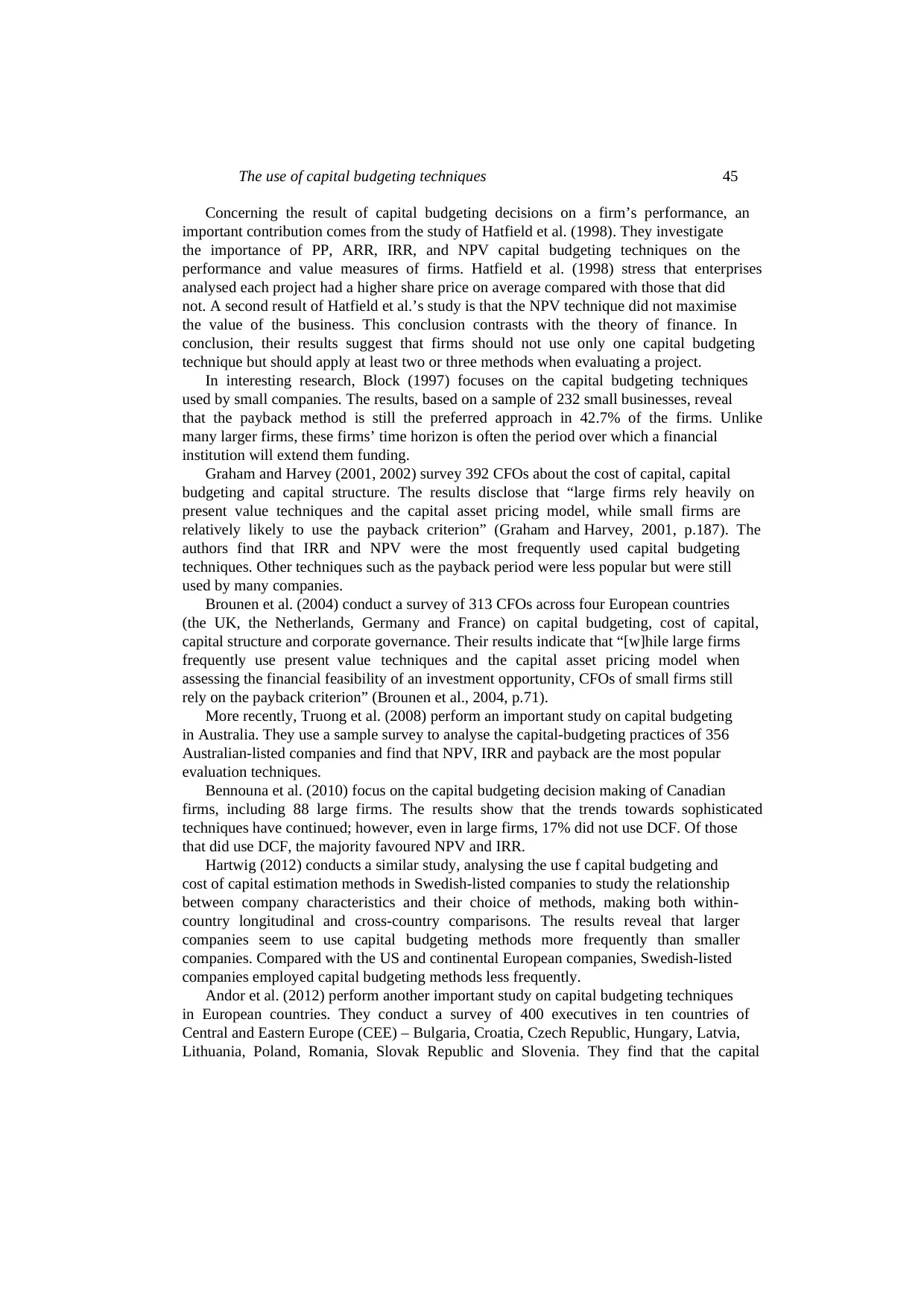
The use of capital budgeting techniques 45
Concerning the result of capital budgeting decisions on a firm’s performance, an
important contribution comes from the study of Hatfield et al. (1998). They investigate
the importance of PP, ARR, IRR, and NPV capital budgeting techniques on the
performance and value measures of firms. Hatfield et al. (1998) stress that enterprises
analysed each project had a higher share price on average compared with those that did
not. A second result of Hatfield et al.’s study is that the NPV technique did not maximise
the value of the business. This conclusion contrasts with the theory of finance. In
conclusion, their results suggest that firms should not use only one capital budgeting
technique but should apply at least two or three methods when evaluating a project.
In interesting research, Block (1997) focuses on the capital budgeting techniques
used by small companies. The results, based on a sample of 232 small businesses, reveal
that the payback method is still the preferred approach in 42.7% of the firms. Unlike
many larger firms, these firms’ time horizon is often the period over which a financial
institution will extend them funding.
Graham and Harvey (2001, 2002) survey 392 CFOs about the cost of capital, capital
budgeting and capital structure. The results disclose that “large firms rely heavily on
present value techniques and the capital asset pricing model, while small firms are
relatively likely to use the payback criterion” (Graham and Harvey, 2001, p.187). The
authors find that IRR and NPV were the most frequently used capital budgeting
techniques. Other techniques such as the payback period were less popular but were still
used by many companies.
Brounen et al. (2004) conduct a survey of 313 CFOs across four European countries
(the UK, the Netherlands, Germany and France) on capital budgeting, cost of capital,
capital structure and corporate governance. Their results indicate that “[w]hile large firms
frequently use present value techniques and the capital asset pricing model when
assessing the financial feasibility of an investment opportunity, CFOs of small firms still
rely on the payback criterion” (Brounen et al., 2004, p.71).
More recently, Truong et al. (2008) perform an important study on capital budgeting
in Australia. They use a sample survey to analyse the capital-budgeting practices of 356
Australian-listed companies and find that NPV, IRR and payback are the most popular
evaluation techniques.
Bennouna et al. (2010) focus on the capital budgeting decision making of Canadian
firms, including 88 large firms. The results show that the trends towards sophisticated
techniques have continued; however, even in large firms, 17% did not use DCF. Of those
that did use DCF, the majority favoured NPV and IRR.
Hartwig (2012) conducts a similar study, analysing the use f capital budgeting and
cost of capital estimation methods in Swedish-listed companies to study the relationship
between company characteristics and their choice of methods, making both within-
country longitudinal and cross-country comparisons. The results reveal that larger
companies seem to use capital budgeting methods more frequently than smaller
companies. Compared with the US and continental European companies, Swedish-listed
companies employed capital budgeting methods less frequently.
Andor et al. (2012) perform another important study on capital budgeting techniques
in European countries. They conduct a survey of 400 executives in ten countries of
Central and Eastern Europe (CEE) – Bulgaria, Croatia, Czech Republic, Hungary, Latvia,
Lithuania, Poland, Romania, Slovak Republic and Slovenia. They find that the capital
Concerning the result of capital budgeting decisions on a firm’s performance, an
important contribution comes from the study of Hatfield et al. (1998). They investigate
the importance of PP, ARR, IRR, and NPV capital budgeting techniques on the
performance and value measures of firms. Hatfield et al. (1998) stress that enterprises
analysed each project had a higher share price on average compared with those that did
not. A second result of Hatfield et al.’s study is that the NPV technique did not maximise
the value of the business. This conclusion contrasts with the theory of finance. In
conclusion, their results suggest that firms should not use only one capital budgeting
technique but should apply at least two or three methods when evaluating a project.
In interesting research, Block (1997) focuses on the capital budgeting techniques
used by small companies. The results, based on a sample of 232 small businesses, reveal
that the payback method is still the preferred approach in 42.7% of the firms. Unlike
many larger firms, these firms’ time horizon is often the period over which a financial
institution will extend them funding.
Graham and Harvey (2001, 2002) survey 392 CFOs about the cost of capital, capital
budgeting and capital structure. The results disclose that “large firms rely heavily on
present value techniques and the capital asset pricing model, while small firms are
relatively likely to use the payback criterion” (Graham and Harvey, 2001, p.187). The
authors find that IRR and NPV were the most frequently used capital budgeting
techniques. Other techniques such as the payback period were less popular but were still
used by many companies.
Brounen et al. (2004) conduct a survey of 313 CFOs across four European countries
(the UK, the Netherlands, Germany and France) on capital budgeting, cost of capital,
capital structure and corporate governance. Their results indicate that “[w]hile large firms
frequently use present value techniques and the capital asset pricing model when
assessing the financial feasibility of an investment opportunity, CFOs of small firms still
rely on the payback criterion” (Brounen et al., 2004, p.71).
More recently, Truong et al. (2008) perform an important study on capital budgeting
in Australia. They use a sample survey to analyse the capital-budgeting practices of 356
Australian-listed companies and find that NPV, IRR and payback are the most popular
evaluation techniques.
Bennouna et al. (2010) focus on the capital budgeting decision making of Canadian
firms, including 88 large firms. The results show that the trends towards sophisticated
techniques have continued; however, even in large firms, 17% did not use DCF. Of those
that did use DCF, the majority favoured NPV and IRR.
Hartwig (2012) conducts a similar study, analysing the use f capital budgeting and
cost of capital estimation methods in Swedish-listed companies to study the relationship
between company characteristics and their choice of methods, making both within-
country longitudinal and cross-country comparisons. The results reveal that larger
companies seem to use capital budgeting methods more frequently than smaller
companies. Compared with the US and continental European companies, Swedish-listed
companies employed capital budgeting methods less frequently.
Andor et al. (2012) perform another important study on capital budgeting techniques
in European countries. They conduct a survey of 400 executives in ten countries of
Central and Eastern Europe (CEE) – Bulgaria, Croatia, Czech Republic, Hungary, Latvia,
Lithuania, Poland, Romania, Slovak Republic and Slovenia. They find that the capital
Paraphrase This Document
Need a fresh take? Get an instant paraphrase of this document with our AI Paraphraser
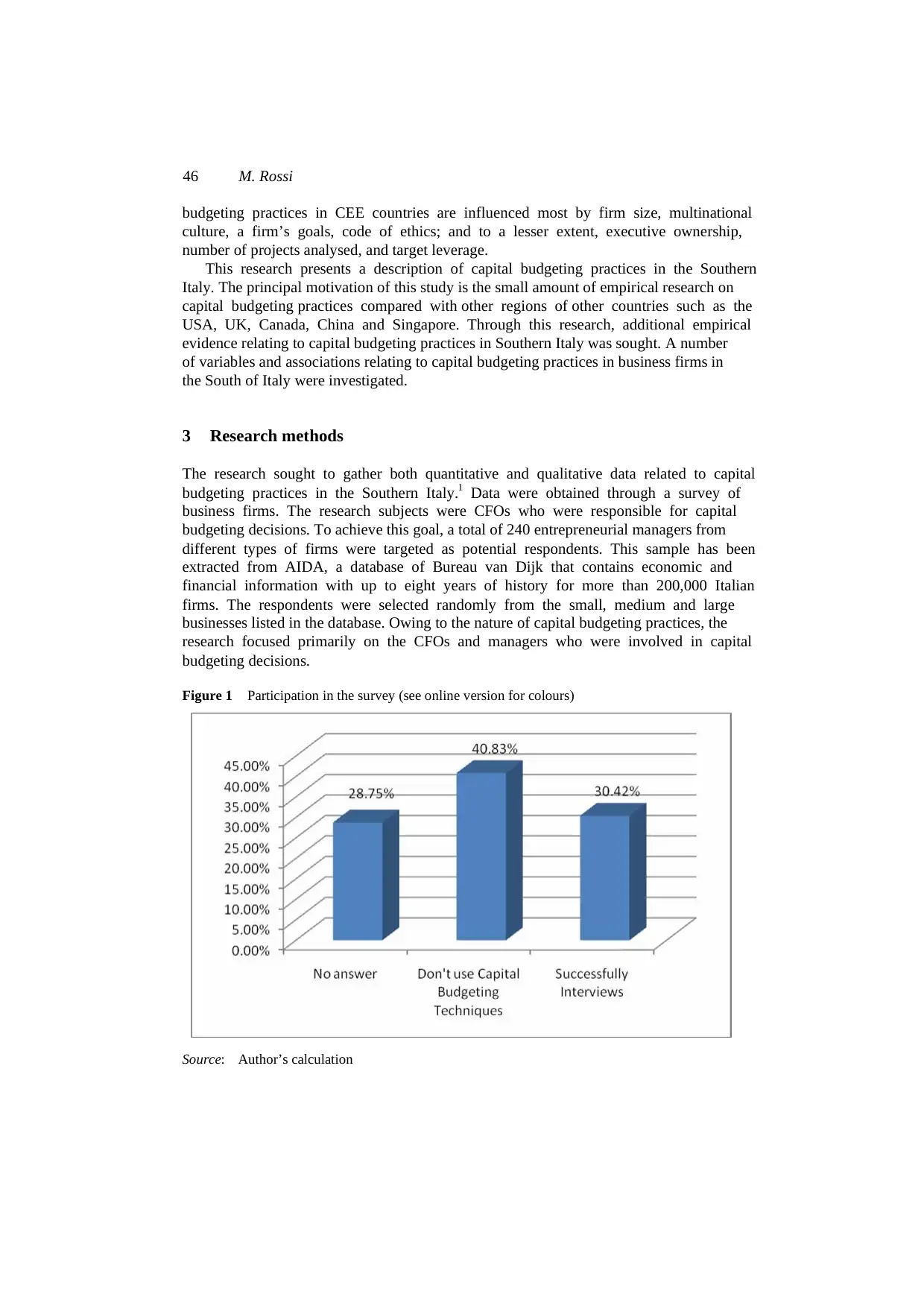
46 M. Rossi
budgeting practices in CEE countries are influenced most by firm size, multinational
culture, a firm’s goals, code of ethics; and to a lesser extent, executive ownership,
number of projects analysed, and target leverage.
This research presents a description of capital budgeting practices in the Southern
Italy. The principal motivation of this study is the small amount of empirical research on
capital budgeting practices compared with other regions of other countries such as the
USA, UK, Canada, China and Singapore. Through this research, additional empirical
evidence relating to capital budgeting practices in Southern Italy was sought. A number
of variables and associations relating to capital budgeting practices in business firms in
the South of Italy were investigated.
3 Research methods
The research sought to gather both quantitative and qualitative data related to capital
budgeting practices in the Southern Italy.1 Data were obtained through a survey of
business firms. The research subjects were CFOs who were responsible for capital
budgeting decisions. To achieve this goal, a total of 240 entrepreneurial managers from
different types of firms were targeted as potential respondents. This sample has been
extracted from AIDA, a database of Bureau van Dijk that contains economic and
financial information with up to eight years of history for more than 200,000 Italian
firms. The respondents were selected randomly from the small, medium and large
businesses listed in the database. Owing to the nature of capital budgeting practices, the
research focused primarily on the CFOs and managers who were involved in capital
budgeting decisions.
Figure 1 Participation in the survey (see online version for colours)
Source: Author’s calculation
budgeting practices in CEE countries are influenced most by firm size, multinational
culture, a firm’s goals, code of ethics; and to a lesser extent, executive ownership,
number of projects analysed, and target leverage.
This research presents a description of capital budgeting practices in the Southern
Italy. The principal motivation of this study is the small amount of empirical research on
capital budgeting practices compared with other regions of other countries such as the
USA, UK, Canada, China and Singapore. Through this research, additional empirical
evidence relating to capital budgeting practices in Southern Italy was sought. A number
of variables and associations relating to capital budgeting practices in business firms in
the South of Italy were investigated.
3 Research methods
The research sought to gather both quantitative and qualitative data related to capital
budgeting practices in the Southern Italy.1 Data were obtained through a survey of
business firms. The research subjects were CFOs who were responsible for capital
budgeting decisions. To achieve this goal, a total of 240 entrepreneurial managers from
different types of firms were targeted as potential respondents. This sample has been
extracted from AIDA, a database of Bureau van Dijk that contains economic and
financial information with up to eight years of history for more than 200,000 Italian
firms. The respondents were selected randomly from the small, medium and large
businesses listed in the database. Owing to the nature of capital budgeting practices, the
research focused primarily on the CFOs and managers who were involved in capital
budgeting decisions.
Figure 1 Participation in the survey (see online version for colours)
Source: Author’s calculation
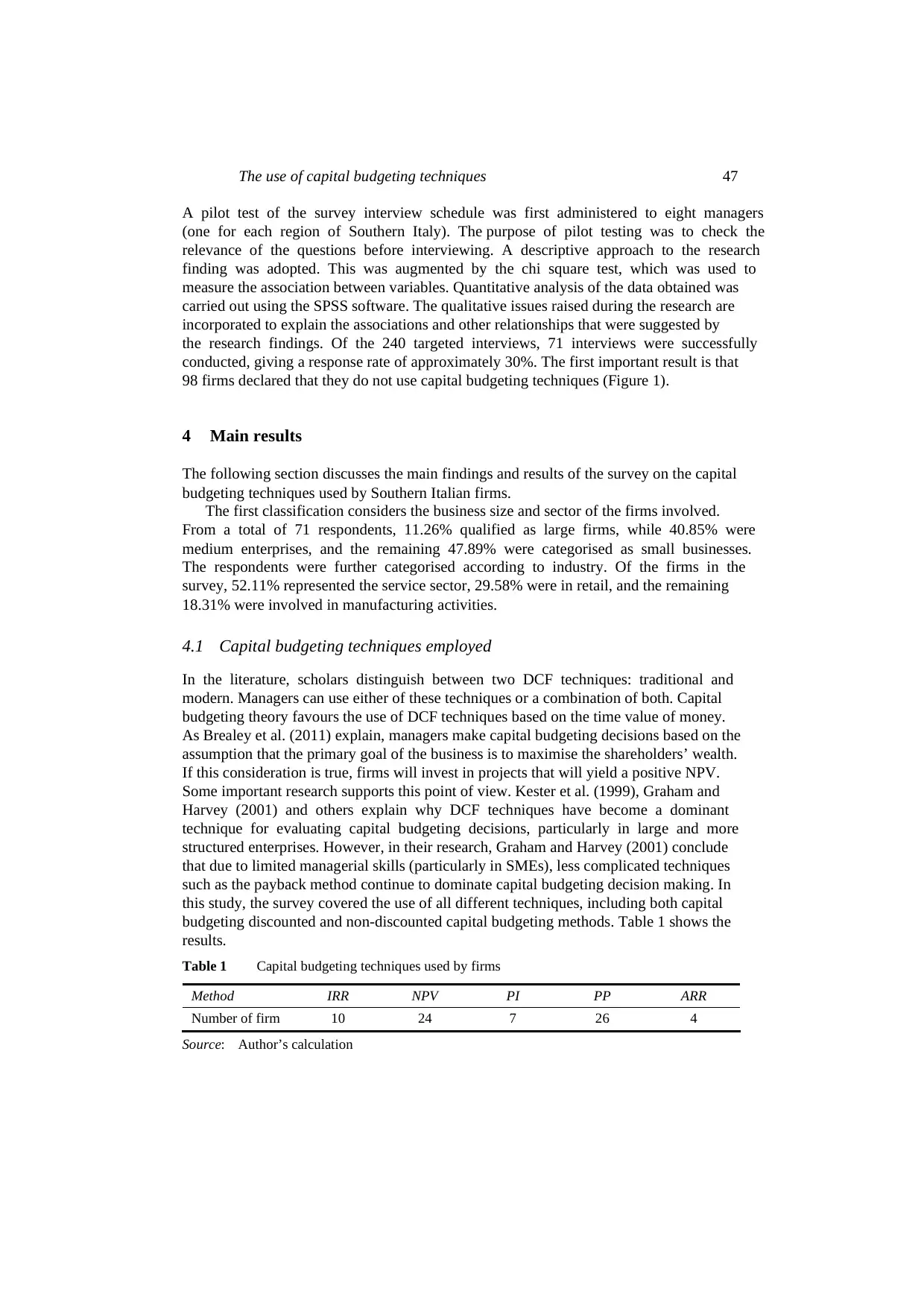
The use of capital budgeting techniques 47
A pilot test of the survey interview schedule was first administered to eight managers
(one for each region of Southern Italy). The purpose of pilot testing was to check the
relevance of the questions before interviewing. A descriptive approach to the research
finding was adopted. This was augmented by the chi square test, which was used to
measure the association between variables. Quantitative analysis of the data obtained was
carried out using the SPSS software. The qualitative issues raised during the research are
incorporated to explain the associations and other relationships that were suggested by
the research findings. Of the 240 targeted interviews, 71 interviews were successfully
conducted, giving a response rate of approximately 30%. The first important result is that
98 firms declared that they do not use capital budgeting techniques (Figure 1).
4 Main results
The following section discusses the main findings and results of the survey on the capital
budgeting techniques used by Southern Italian firms.
The first classification considers the business size and sector of the firms involved.
From a total of 71 respondents, 11.26% qualified as large firms, while 40.85% were
medium enterprises, and the remaining 47.89% were categorised as small businesses.
The respondents were further categorised according to industry. Of the firms in the
survey, 52.11% represented the service sector, 29.58% were in retail, and the remaining
18.31% were involved in manufacturing activities.
4.1 Capital budgeting techniques employed
In the literature, scholars distinguish between two DCF techniques: traditional and
modern. Managers can use either of these techniques or a combination of both. Capital
budgeting theory favours the use of DCF techniques based on the time value of money.
As Brealey et al. (2011) explain, managers make capital budgeting decisions based on the
assumption that the primary goal of the business is to maximise the shareholders’ wealth.
If this consideration is true, firms will invest in projects that will yield a positive NPV.
Some important research supports this point of view. Kester et al. (1999), Graham and
Harvey (2001) and others explain why DCF techniques have become a dominant
technique for evaluating capital budgeting decisions, particularly in large and more
structured enterprises. However, in their research, Graham and Harvey (2001) conclude
that due to limited managerial skills (particularly in SMEs), less complicated techniques
such as the payback method continue to dominate capital budgeting decision making. In
this study, the survey covered the use of all different techniques, including both capital
budgeting discounted and non-discounted capital budgeting methods. Table 1 shows the
results.
Table 1 Capital budgeting techniques used by firms
Method IRR NPV PI PP ARR
Number of firm 10 24 7 26 4
Source: Author’s calculation
A pilot test of the survey interview schedule was first administered to eight managers
(one for each region of Southern Italy). The purpose of pilot testing was to check the
relevance of the questions before interviewing. A descriptive approach to the research
finding was adopted. This was augmented by the chi square test, which was used to
measure the association between variables. Quantitative analysis of the data obtained was
carried out using the SPSS software. The qualitative issues raised during the research are
incorporated to explain the associations and other relationships that were suggested by
the research findings. Of the 240 targeted interviews, 71 interviews were successfully
conducted, giving a response rate of approximately 30%. The first important result is that
98 firms declared that they do not use capital budgeting techniques (Figure 1).
4 Main results
The following section discusses the main findings and results of the survey on the capital
budgeting techniques used by Southern Italian firms.
The first classification considers the business size and sector of the firms involved.
From a total of 71 respondents, 11.26% qualified as large firms, while 40.85% were
medium enterprises, and the remaining 47.89% were categorised as small businesses.
The respondents were further categorised according to industry. Of the firms in the
survey, 52.11% represented the service sector, 29.58% were in retail, and the remaining
18.31% were involved in manufacturing activities.
4.1 Capital budgeting techniques employed
In the literature, scholars distinguish between two DCF techniques: traditional and
modern. Managers can use either of these techniques or a combination of both. Capital
budgeting theory favours the use of DCF techniques based on the time value of money.
As Brealey et al. (2011) explain, managers make capital budgeting decisions based on the
assumption that the primary goal of the business is to maximise the shareholders’ wealth.
If this consideration is true, firms will invest in projects that will yield a positive NPV.
Some important research supports this point of view. Kester et al. (1999), Graham and
Harvey (2001) and others explain why DCF techniques have become a dominant
technique for evaluating capital budgeting decisions, particularly in large and more
structured enterprises. However, in their research, Graham and Harvey (2001) conclude
that due to limited managerial skills (particularly in SMEs), less complicated techniques
such as the payback method continue to dominate capital budgeting decision making. In
this study, the survey covered the use of all different techniques, including both capital
budgeting discounted and non-discounted capital budgeting methods. Table 1 shows the
results.
Table 1 Capital budgeting techniques used by firms
Method IRR NPV PI PP ARR
Number of firm 10 24 7 26 4
Source: Author’s calculation
⊘ This is a preview!⊘
Do you want full access?
Subscribe today to unlock all pages.

Trusted by 1+ million students worldwide
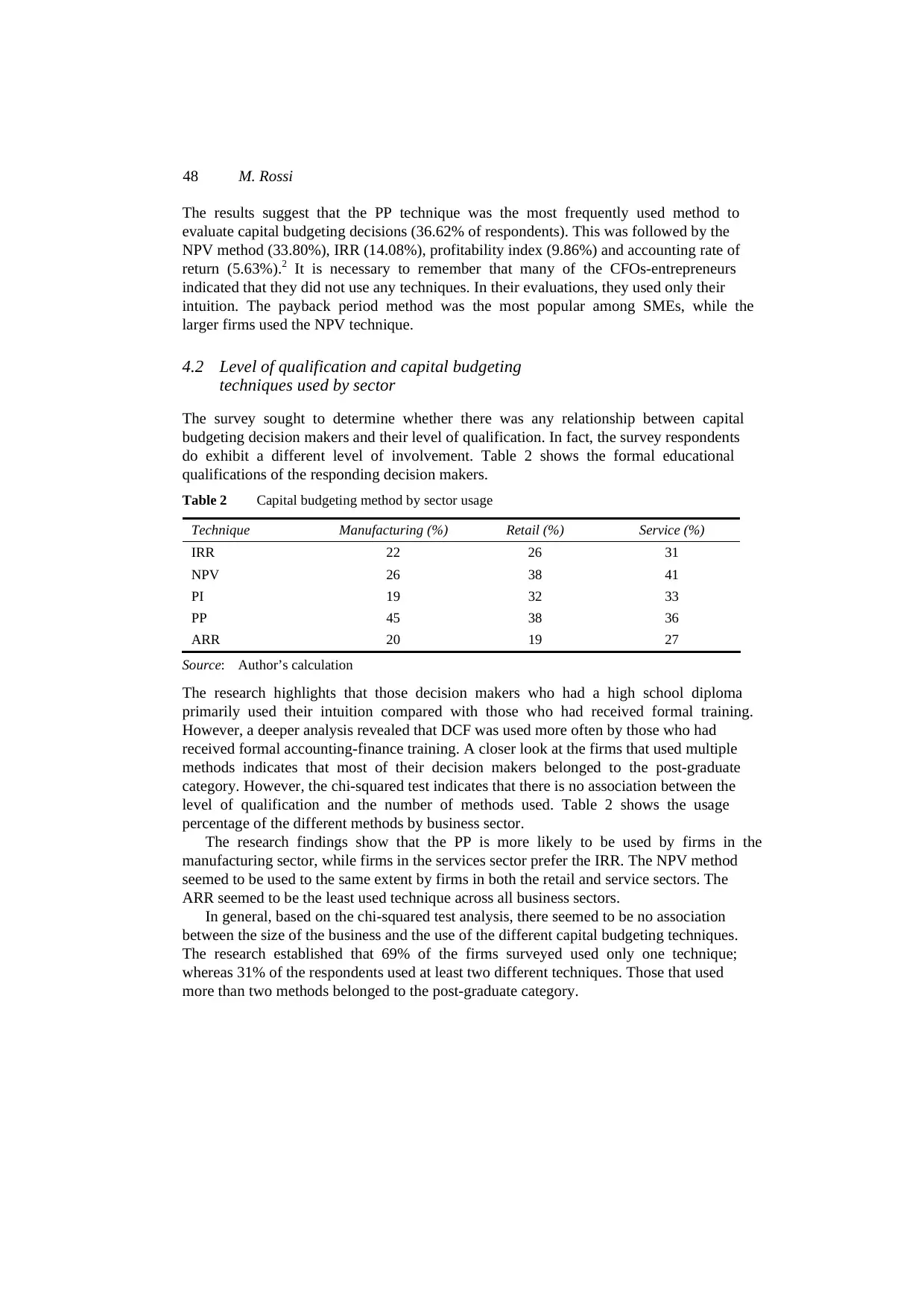
48 M. Rossi
The results suggest that the PP technique was the most frequently used method to
evaluate capital budgeting decisions (36.62% of respondents). This was followed by the
NPV method (33.80%), IRR (14.08%), profitability index (9.86%) and accounting rate of
return (5.63%).2 It is necessary to remember that many of the CFOs-entrepreneurs
indicated that they did not use any techniques. In their evaluations, they used only their
intuition. The payback period method was the most popular among SMEs, while the
larger firms used the NPV technique.
4.2 Level of qualification and capital budgeting
techniques used by sector
The survey sought to determine whether there was any relationship between capital
budgeting decision makers and their level of qualification. In fact, the survey respondents
do exhibit a different level of involvement. Table 2 shows the formal educational
qualifications of the responding decision makers.
Table 2 Capital budgeting method by sector usage
Technique Manufacturing (%) Retail (%) Service (%)
IRR 22 26 31
NPV 26 38 41
PI 19 32 33
PP 45 38 36
ARR 20 19 27
Source: Author’s calculation
The research highlights that those decision makers who had a high school diploma
primarily used their intuition compared with those who had received formal training.
However, a deeper analysis revealed that DCF was used more often by those who had
received formal accounting-finance training. A closer look at the firms that used multiple
methods indicates that most of their decision makers belonged to the post-graduate
category. However, the chi-squared test indicates that there is no association between the
level of qualification and the number of methods used. Table 2 shows the usage
percentage of the different methods by business sector.
The research findings show that the PP is more likely to be used by firms in the
manufacturing sector, while firms in the services sector prefer the IRR. The NPV method
seemed to be used to the same extent by firms in both the retail and service sectors. The
ARR seemed to be the least used technique across all business sectors.
In general, based on the chi-squared test analysis, there seemed to be no association
between the size of the business and the use of the different capital budgeting techniques.
The research established that 69% of the firms surveyed used only one technique;
whereas 31% of the respondents used at least two different techniques. Those that used
more than two methods belonged to the post-graduate category.
The results suggest that the PP technique was the most frequently used method to
evaluate capital budgeting decisions (36.62% of respondents). This was followed by the
NPV method (33.80%), IRR (14.08%), profitability index (9.86%) and accounting rate of
return (5.63%).2 It is necessary to remember that many of the CFOs-entrepreneurs
indicated that they did not use any techniques. In their evaluations, they used only their
intuition. The payback period method was the most popular among SMEs, while the
larger firms used the NPV technique.
4.2 Level of qualification and capital budgeting
techniques used by sector
The survey sought to determine whether there was any relationship between capital
budgeting decision makers and their level of qualification. In fact, the survey respondents
do exhibit a different level of involvement. Table 2 shows the formal educational
qualifications of the responding decision makers.
Table 2 Capital budgeting method by sector usage
Technique Manufacturing (%) Retail (%) Service (%)
IRR 22 26 31
NPV 26 38 41
PI 19 32 33
PP 45 38 36
ARR 20 19 27
Source: Author’s calculation
The research highlights that those decision makers who had a high school diploma
primarily used their intuition compared with those who had received formal training.
However, a deeper analysis revealed that DCF was used more often by those who had
received formal accounting-finance training. A closer look at the firms that used multiple
methods indicates that most of their decision makers belonged to the post-graduate
category. However, the chi-squared test indicates that there is no association between the
level of qualification and the number of methods used. Table 2 shows the usage
percentage of the different methods by business sector.
The research findings show that the PP is more likely to be used by firms in the
manufacturing sector, while firms in the services sector prefer the IRR. The NPV method
seemed to be used to the same extent by firms in both the retail and service sectors. The
ARR seemed to be the least used technique across all business sectors.
In general, based on the chi-squared test analysis, there seemed to be no association
between the size of the business and the use of the different capital budgeting techniques.
The research established that 69% of the firms surveyed used only one technique;
whereas 31% of the respondents used at least two different techniques. Those that used
more than two methods belonged to the post-graduate category.
Paraphrase This Document
Need a fresh take? Get an instant paraphrase of this document with our AI Paraphraser
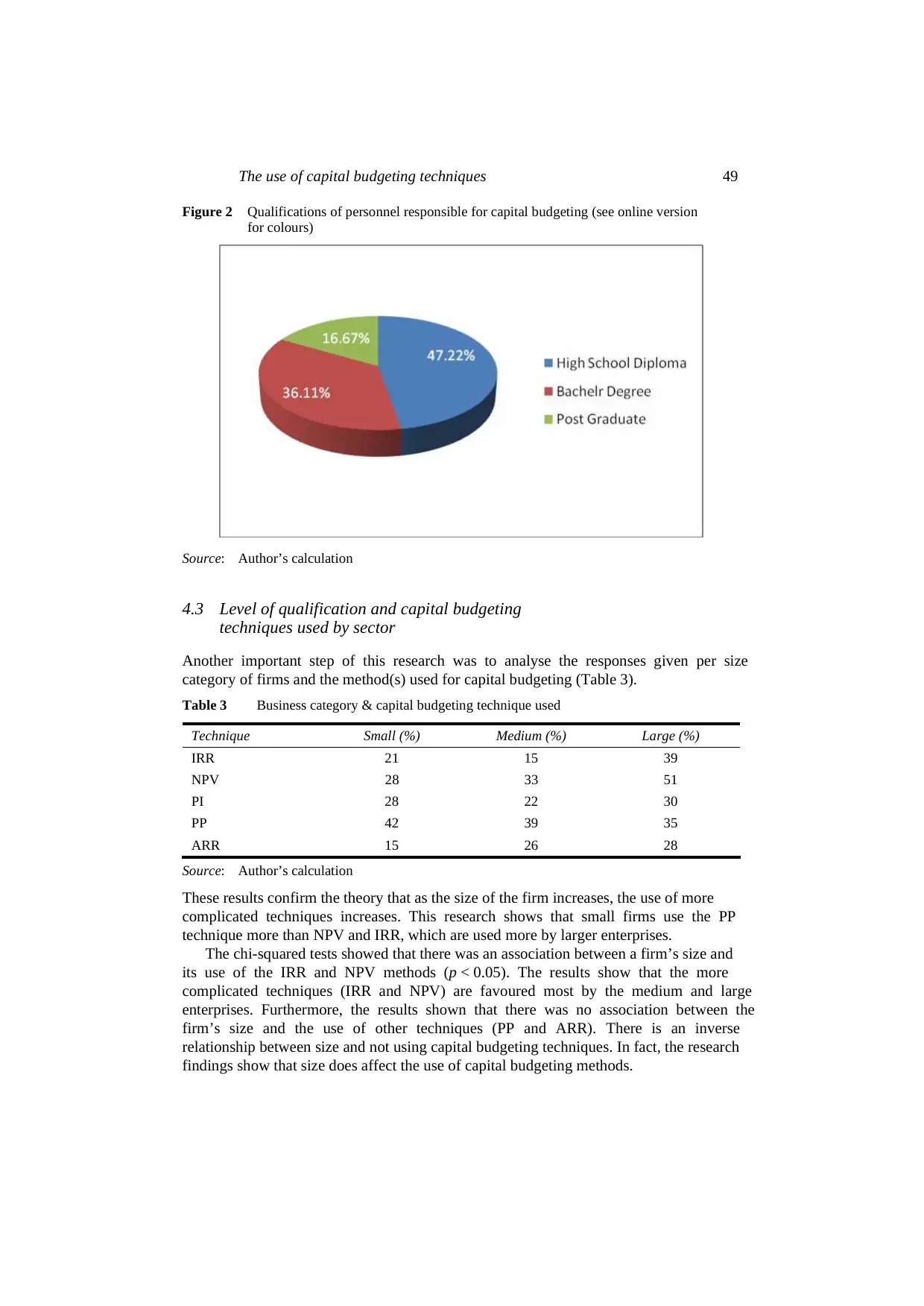
The use of capital budgeting techniques 49
Figure 2 Qualifications of personnel responsible for capital budgeting (see online version
for colours)
Source: Author’s calculation
4.3 Level of qualification and capital budgeting
techniques used by sector
Another important step of this research was to analyse the responses given per size
category of firms and the method(s) used for capital budgeting (Table 3).
Table 3 Business category & capital budgeting technique used
Technique Small (%) Medium (%) Large (%)
IRR 21 15 39
NPV 28 33 51
PI 28 22 30
PP 42 39 35
ARR 15 26 28
Source: Author’s calculation
These results confirm the theory that as the size of the firm increases, the use of more
complicated techniques increases. This research shows that small firms use the PP
technique more than NPV and IRR, which are used more by larger enterprises.
The chi-squared tests showed that there was an association between a firm’s size and
its use of the IRR and NPV methods (p < 0.05). The results show that the more
complicated techniques (IRR and NPV) are favoured most by the medium and large
enterprises. Furthermore, the results shown that there was no association between the
firm’s size and the use of other techniques (PP and ARR). There is an inverse
relationship between size and not using capital budgeting techniques. In fact, the research
findings show that size does affect the use of capital budgeting methods.
Figure 2 Qualifications of personnel responsible for capital budgeting (see online version
for colours)
Source: Author’s calculation
4.3 Level of qualification and capital budgeting
techniques used by sector
Another important step of this research was to analyse the responses given per size
category of firms and the method(s) used for capital budgeting (Table 3).
Table 3 Business category & capital budgeting technique used
Technique Small (%) Medium (%) Large (%)
IRR 21 15 39
NPV 28 33 51
PI 28 22 30
PP 42 39 35
ARR 15 26 28
Source: Author’s calculation
These results confirm the theory that as the size of the firm increases, the use of more
complicated techniques increases. This research shows that small firms use the PP
technique more than NPV and IRR, which are used more by larger enterprises.
The chi-squared tests showed that there was an association between a firm’s size and
its use of the IRR and NPV methods (p < 0.05). The results show that the more
complicated techniques (IRR and NPV) are favoured most by the medium and large
enterprises. Furthermore, the results shown that there was no association between the
firm’s size and the use of other techniques (PP and ARR). There is an inverse
relationship between size and not using capital budgeting techniques. In fact, the research
findings show that size does affect the use of capital budgeting methods.
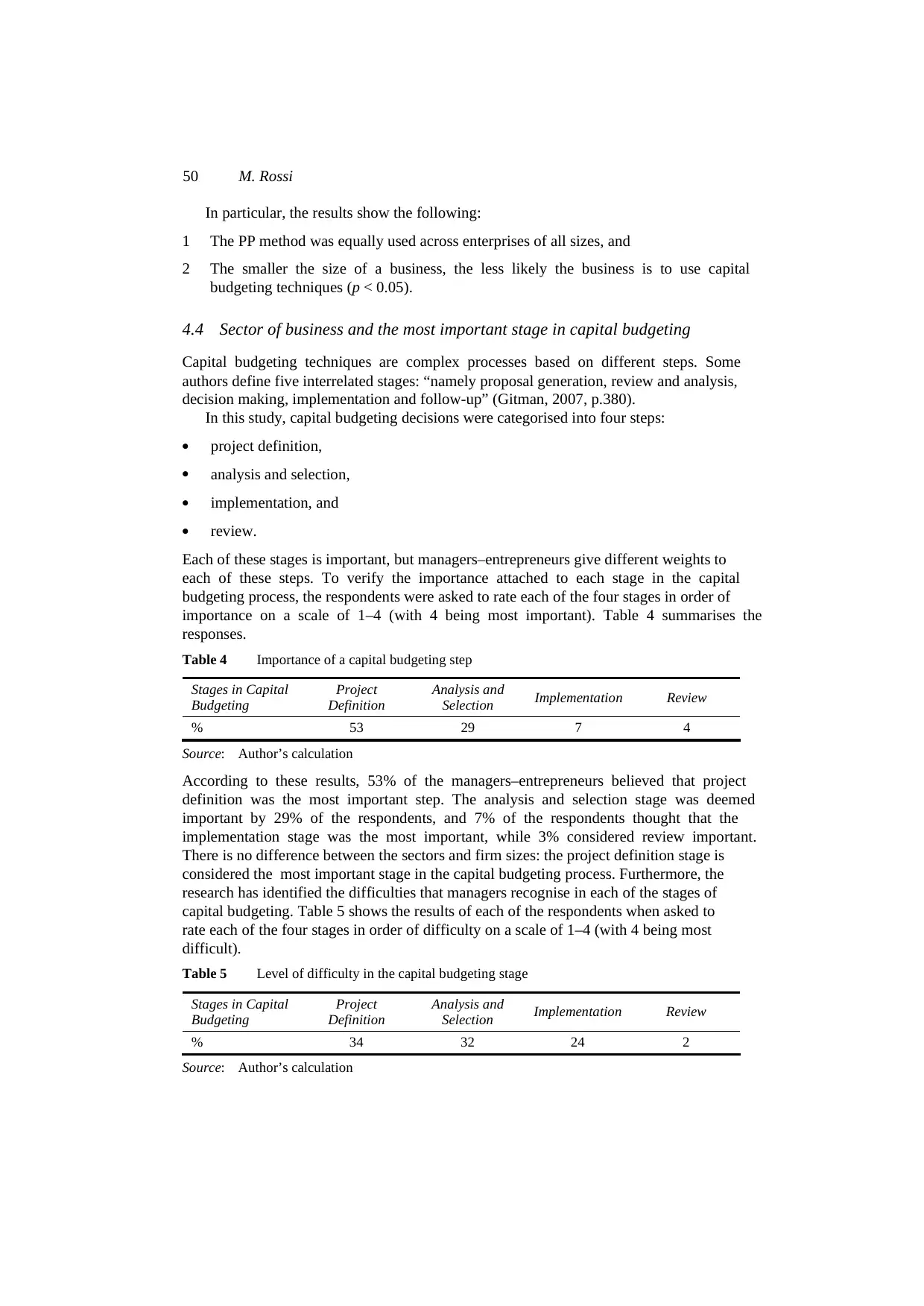
50 M. Rossi
In particular, the results show the following:
1 The PP method was equally used across enterprises of all sizes, and
2 The smaller the size of a business, the less likely the business is to use capital
budgeting techniques (p < 0.05).
4.4 Sector of business and the most important stage in capital budgeting
Capital budgeting techniques are complex processes based on different steps. Some
authors define five interrelated stages: “namely proposal generation, review and analysis,
decision making, implementation and follow-up” (Gitman, 2007, p.380).
In this study, capital budgeting decisions were categorised into four steps:
project definition,
analysis and selection,
implementation, and
review.
Each of these stages is important, but managers–entrepreneurs give different weights to
each of these steps. To verify the importance attached to each stage in the capital
budgeting process, the respondents were asked to rate each of the four stages in order of
importance on a scale of 1–4 (with 4 being most important). Table 4 summarises the
responses.
Table 4 Importance of a capital budgeting step
Stages in Capital
Budgeting
Project
Definition
Analysis and
Selection Implementation Review
% 53 29 7 4
Source: Author’s calculation
According to these results, 53% of the managers–entrepreneurs believed that project
definition was the most important step. The analysis and selection stage was deemed
important by 29% of the respondents, and 7% of the respondents thought that the
implementation stage was the most important, while 3% considered review important.
There is no difference between the sectors and firm sizes: the project definition stage is
considered the most important stage in the capital budgeting process. Furthermore, the
research has identified the difficulties that managers recognise in each of the stages of
capital budgeting. Table 5 shows the results of each of the respondents when asked to
rate each of the four stages in order of difficulty on a scale of 1–4 (with 4 being most
difficult).
Table 5 Level of difficulty in the capital budgeting stage
Stages in Capital
Budgeting
Project
Definition
Analysis and
Selection Implementation Review
% 34 32 24 2
Source: Author’s calculation
In particular, the results show the following:
1 The PP method was equally used across enterprises of all sizes, and
2 The smaller the size of a business, the less likely the business is to use capital
budgeting techniques (p < 0.05).
4.4 Sector of business and the most important stage in capital budgeting
Capital budgeting techniques are complex processes based on different steps. Some
authors define five interrelated stages: “namely proposal generation, review and analysis,
decision making, implementation and follow-up” (Gitman, 2007, p.380).
In this study, capital budgeting decisions were categorised into four steps:
project definition,
analysis and selection,
implementation, and
review.
Each of these stages is important, but managers–entrepreneurs give different weights to
each of these steps. To verify the importance attached to each stage in the capital
budgeting process, the respondents were asked to rate each of the four stages in order of
importance on a scale of 1–4 (with 4 being most important). Table 4 summarises the
responses.
Table 4 Importance of a capital budgeting step
Stages in Capital
Budgeting
Project
Definition
Analysis and
Selection Implementation Review
% 53 29 7 4
Source: Author’s calculation
According to these results, 53% of the managers–entrepreneurs believed that project
definition was the most important step. The analysis and selection stage was deemed
important by 29% of the respondents, and 7% of the respondents thought that the
implementation stage was the most important, while 3% considered review important.
There is no difference between the sectors and firm sizes: the project definition stage is
considered the most important stage in the capital budgeting process. Furthermore, the
research has identified the difficulties that managers recognise in each of the stages of
capital budgeting. Table 5 shows the results of each of the respondents when asked to
rate each of the four stages in order of difficulty on a scale of 1–4 (with 4 being most
difficult).
Table 5 Level of difficulty in the capital budgeting stage
Stages in Capital
Budgeting
Project
Definition
Analysis and
Selection Implementation Review
% 34 32 24 2
Source: Author’s calculation
⊘ This is a preview!⊘
Do you want full access?
Subscribe today to unlock all pages.

Trusted by 1+ million students worldwide
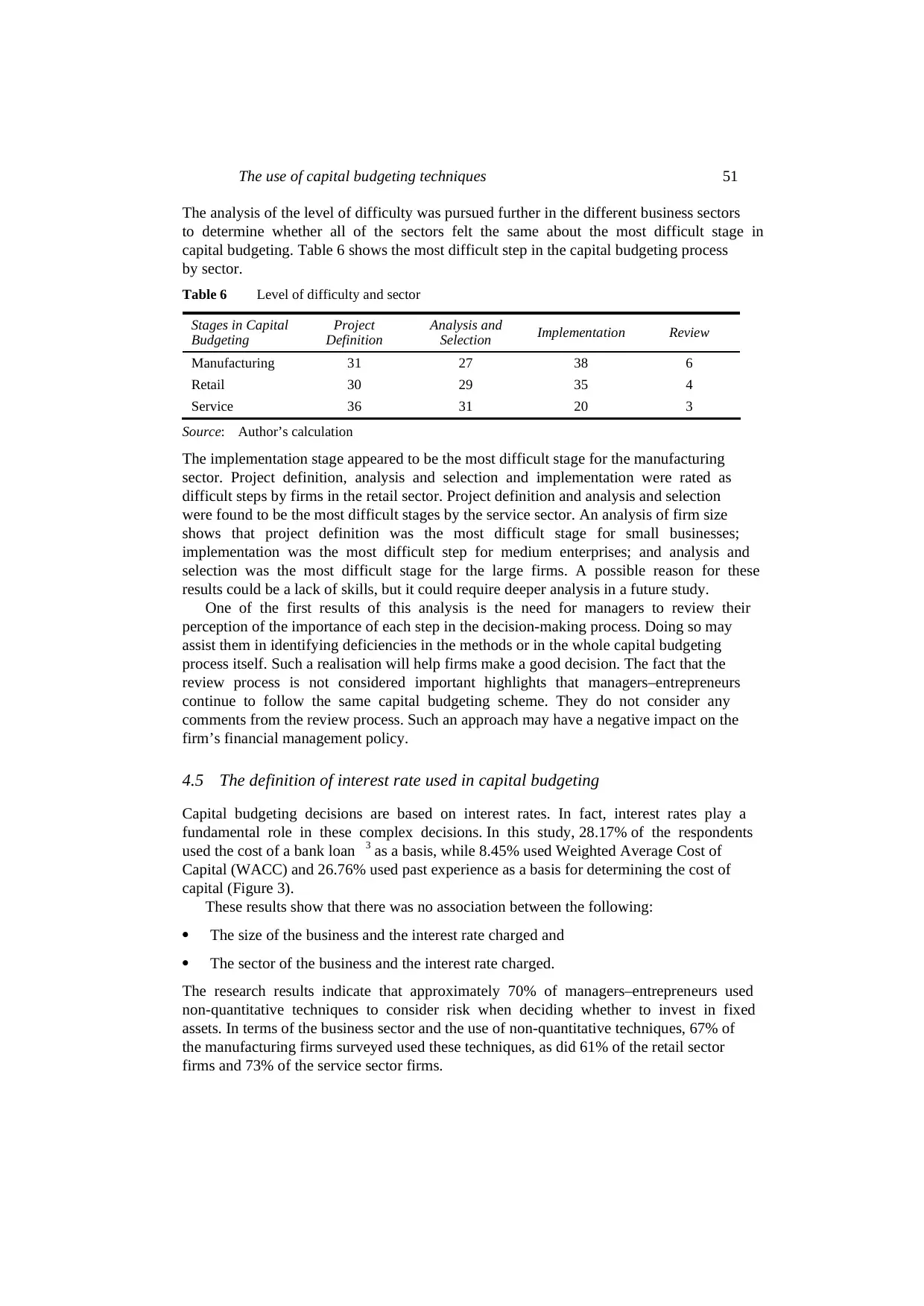
The use of capital budgeting techniques 51
The analysis of the level of difficulty was pursued further in the different business sectors
to determine whether all of the sectors felt the same about the most difficult stage in
capital budgeting. Table 6 shows the most difficult step in the capital budgeting process
by sector.
Table 6 Level of difficulty and sector
Stages in Capital
Budgeting
Project
Definition
Analysis and
Selection Implementation Review
Manufacturing 31 27 38 6
Retail 30 29 35 4
Service 36 31 20 3
Source: Author’s calculation
The implementation stage appeared to be the most difficult stage for the manufacturing
sector. Project definition, analysis and selection and implementation were rated as
difficult steps by firms in the retail sector. Project definition and analysis and selection
were found to be the most difficult stages by the service sector. An analysis of firm size
shows that project definition was the most difficult stage for small businesses;
implementation was the most difficult step for medium enterprises; and analysis and
selection was the most difficult stage for the large firms. A possible reason for these
results could be a lack of skills, but it could require deeper analysis in a future study.
One of the first results of this analysis is the need for managers to review their
perception of the importance of each step in the decision-making process. Doing so may
assist them in identifying deficiencies in the methods or in the whole capital budgeting
process itself. Such a realisation will help firms make a good decision. The fact that the
review process is not considered important highlights that managers–entrepreneurs
continue to follow the same capital budgeting scheme. They do not consider any
comments from the review process. Such an approach may have a negative impact on the
firm’s financial management policy.
4.5 The definition of interest rate used in capital budgeting
Capital budgeting decisions are based on interest rates. In fact, interest rates play a
fundamental role in these complex decisions. In this study, 28.17% of the respondents
used the cost of a bank loan 3 as a basis, while 8.45% used Weighted Average Cost of
Capital (WACC) and 26.76% used past experience as a basis for determining the cost of
capital (Figure 3).
These results show that there was no association between the following:
The size of the business and the interest rate charged and
The sector of the business and the interest rate charged.
The research results indicate that approximately 70% of managers–entrepreneurs used
non-quantitative techniques to consider risk when deciding whether to invest in fixed
assets. In terms of the business sector and the use of non-quantitative techniques, 67% of
the manufacturing firms surveyed used these techniques, as did 61% of the retail sector
firms and 73% of the service sector firms.
The analysis of the level of difficulty was pursued further in the different business sectors
to determine whether all of the sectors felt the same about the most difficult stage in
capital budgeting. Table 6 shows the most difficult step in the capital budgeting process
by sector.
Table 6 Level of difficulty and sector
Stages in Capital
Budgeting
Project
Definition
Analysis and
Selection Implementation Review
Manufacturing 31 27 38 6
Retail 30 29 35 4
Service 36 31 20 3
Source: Author’s calculation
The implementation stage appeared to be the most difficult stage for the manufacturing
sector. Project definition, analysis and selection and implementation were rated as
difficult steps by firms in the retail sector. Project definition and analysis and selection
were found to be the most difficult stages by the service sector. An analysis of firm size
shows that project definition was the most difficult stage for small businesses;
implementation was the most difficult step for medium enterprises; and analysis and
selection was the most difficult stage for the large firms. A possible reason for these
results could be a lack of skills, but it could require deeper analysis in a future study.
One of the first results of this analysis is the need for managers to review their
perception of the importance of each step in the decision-making process. Doing so may
assist them in identifying deficiencies in the methods or in the whole capital budgeting
process itself. Such a realisation will help firms make a good decision. The fact that the
review process is not considered important highlights that managers–entrepreneurs
continue to follow the same capital budgeting scheme. They do not consider any
comments from the review process. Such an approach may have a negative impact on the
firm’s financial management policy.
4.5 The definition of interest rate used in capital budgeting
Capital budgeting decisions are based on interest rates. In fact, interest rates play a
fundamental role in these complex decisions. In this study, 28.17% of the respondents
used the cost of a bank loan 3 as a basis, while 8.45% used Weighted Average Cost of
Capital (WACC) and 26.76% used past experience as a basis for determining the cost of
capital (Figure 3).
These results show that there was no association between the following:
The size of the business and the interest rate charged and
The sector of the business and the interest rate charged.
The research results indicate that approximately 70% of managers–entrepreneurs used
non-quantitative techniques to consider risk when deciding whether to invest in fixed
assets. In terms of the business sector and the use of non-quantitative techniques, 67% of
the manufacturing firms surveyed used these techniques, as did 61% of the retail sector
firms and 73% of the service sector firms.
Paraphrase This Document
Need a fresh take? Get an instant paraphrase of this document with our AI Paraphraser
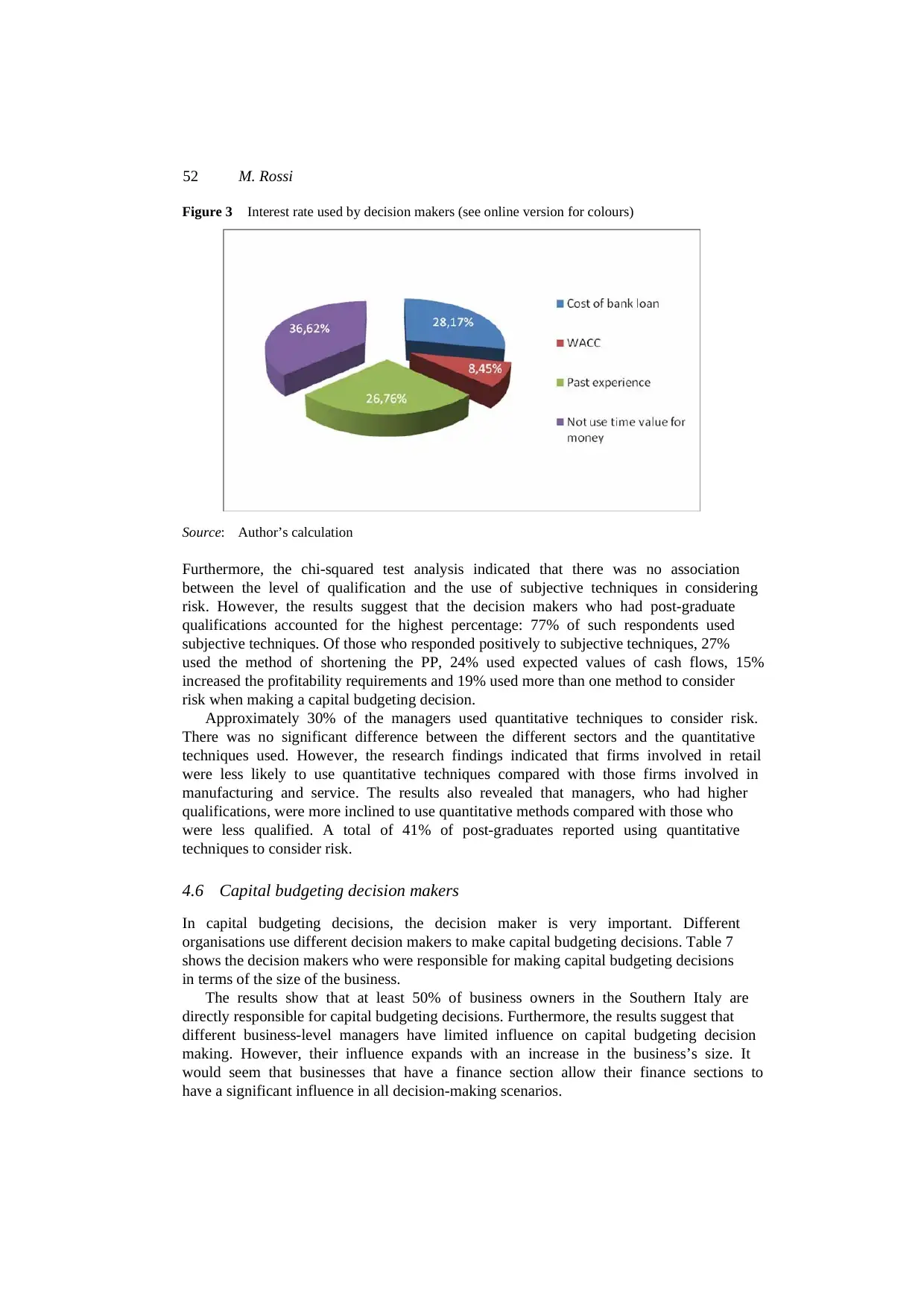
52 M. Rossi
Figure 3 Interest rate used by decision makers (see online version for colours)
Source: Author’s calculation
Furthermore, the chi-squared test analysis indicated that there was no association
between the level of qualification and the use of subjective techniques in considering
risk. However, the results suggest that the decision makers who had post-graduate
qualifications accounted for the highest percentage: 77% of such respondents used
subjective techniques. Of those who responded positively to subjective techniques, 27%
used the method of shortening the PP, 24% used expected values of cash flows, 15%
increased the profitability requirements and 19% used more than one method to consider
risk when making a capital budgeting decision.
Approximately 30% of the managers used quantitative techniques to consider risk.
There was no significant difference between the different sectors and the quantitative
techniques used. However, the research findings indicated that firms involved in retail
were less likely to use quantitative techniques compared with those firms involved in
manufacturing and service. The results also revealed that managers, who had higher
qualifications, were more inclined to use quantitative methods compared with those who
were less qualified. A total of 41% of post-graduates reported using quantitative
techniques to consider risk.
4.6 Capital budgeting decision makers
In capital budgeting decisions, the decision maker is very important. Different
organisations use different decision makers to make capital budgeting decisions. Table 7
shows the decision makers who were responsible for making capital budgeting decisions
in terms of the size of the business.
The results show that at least 50% of business owners in the Southern Italy are
directly responsible for capital budgeting decisions. Furthermore, the results suggest that
different business-level managers have limited influence on capital budgeting decision
making. However, their influence expands with an increase in the business’s size. It
would seem that businesses that have a finance section allow their finance sections to
have a significant influence in all decision-making scenarios.
Figure 3 Interest rate used by decision makers (see online version for colours)
Source: Author’s calculation
Furthermore, the chi-squared test analysis indicated that there was no association
between the level of qualification and the use of subjective techniques in considering
risk. However, the results suggest that the decision makers who had post-graduate
qualifications accounted for the highest percentage: 77% of such respondents used
subjective techniques. Of those who responded positively to subjective techniques, 27%
used the method of shortening the PP, 24% used expected values of cash flows, 15%
increased the profitability requirements and 19% used more than one method to consider
risk when making a capital budgeting decision.
Approximately 30% of the managers used quantitative techniques to consider risk.
There was no significant difference between the different sectors and the quantitative
techniques used. However, the research findings indicated that firms involved in retail
were less likely to use quantitative techniques compared with those firms involved in
manufacturing and service. The results also revealed that managers, who had higher
qualifications, were more inclined to use quantitative methods compared with those who
were less qualified. A total of 41% of post-graduates reported using quantitative
techniques to consider risk.
4.6 Capital budgeting decision makers
In capital budgeting decisions, the decision maker is very important. Different
organisations use different decision makers to make capital budgeting decisions. Table 7
shows the decision makers who were responsible for making capital budgeting decisions
in terms of the size of the business.
The results show that at least 50% of business owners in the Southern Italy are
directly responsible for capital budgeting decisions. Furthermore, the results suggest that
different business-level managers have limited influence on capital budgeting decision
making. However, their influence expands with an increase in the business’s size. It
would seem that businesses that have a finance section allow their finance sections to
have a significant influence in all decision-making scenarios.
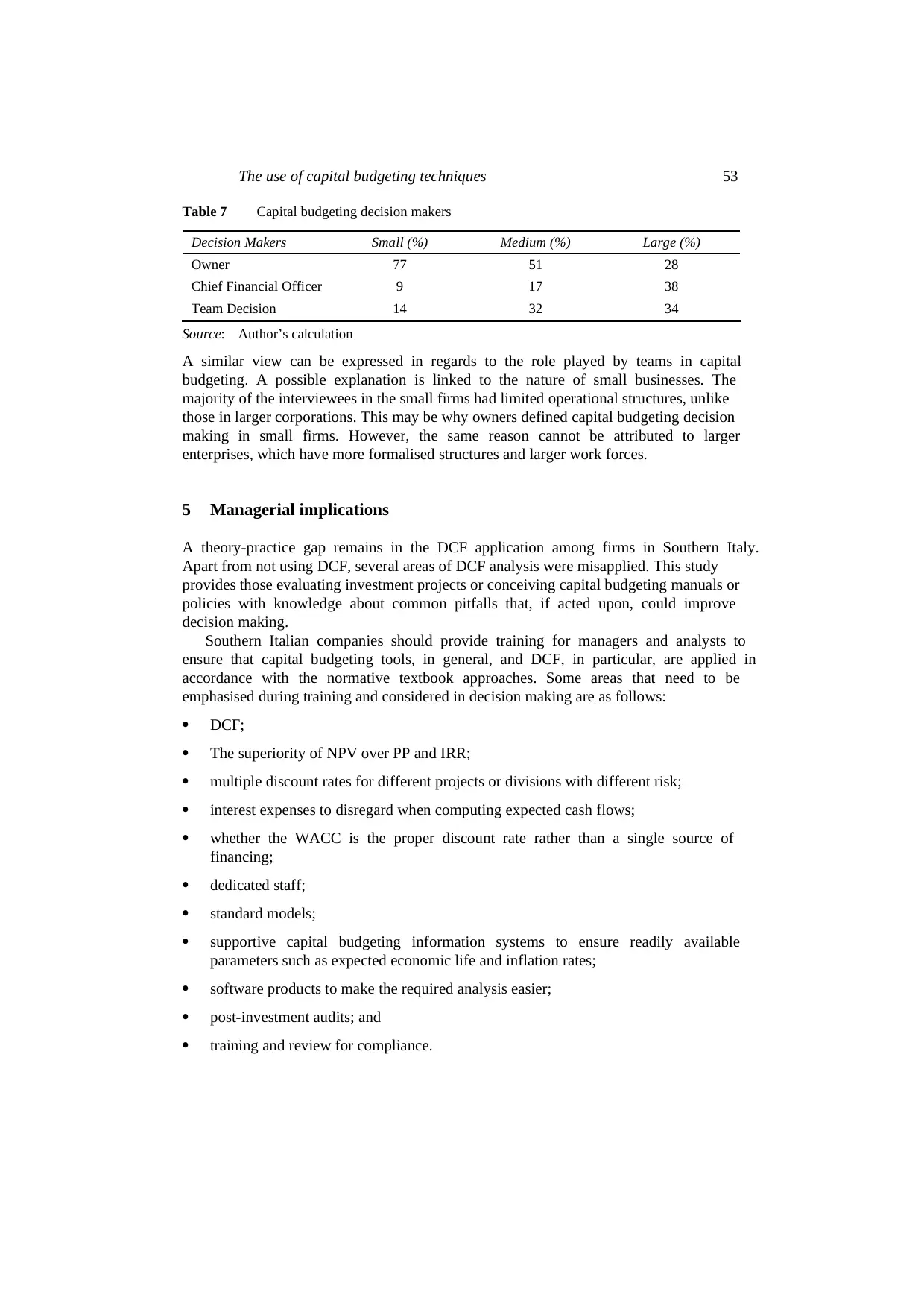
The use of capital budgeting techniques 53
Table 7 Capital budgeting decision makers
Decision Makers Small (%) Medium (%) Large (%)
Owner 77 51 28
Chief Financial Officer 9 17 38
Team Decision 14 32 34
Source: Author’s calculation
A similar view can be expressed in regards to the role played by teams in capital
budgeting. A possible explanation is linked to the nature of small businesses. The
majority of the interviewees in the small firms had limited operational structures, unlike
those in larger corporations. This may be why owners defined capital budgeting decision
making in small firms. However, the same reason cannot be attributed to larger
enterprises, which have more formalised structures and larger work forces.
5 Managerial implications
A theory-practice gap remains in the DCF application among firms in Southern Italy.
Apart from not using DCF, several areas of DCF analysis were misapplied. This study
provides those evaluating investment projects or conceiving capital budgeting manuals or
policies with knowledge about common pitfalls that, if acted upon, could improve
decision making.
Southern Italian companies should provide training for managers and analysts to
ensure that capital budgeting tools, in general, and DCF, in particular, are applied in
accordance with the normative textbook approaches. Some areas that need to be
emphasised during training and considered in decision making are as follows:
DCF;
The superiority of NPV over PP and IRR;
multiple discount rates for different projects or divisions with different risk;
interest expenses to disregard when computing expected cash flows;
whether the WACC is the proper discount rate rather than a single source of
financing;
dedicated staff;
standard models;
supportive capital budgeting information systems to ensure readily available
parameters such as expected economic life and inflation rates;
software products to make the required analysis easier;
post-investment audits; and
training and review for compliance.
Table 7 Capital budgeting decision makers
Decision Makers Small (%) Medium (%) Large (%)
Owner 77 51 28
Chief Financial Officer 9 17 38
Team Decision 14 32 34
Source: Author’s calculation
A similar view can be expressed in regards to the role played by teams in capital
budgeting. A possible explanation is linked to the nature of small businesses. The
majority of the interviewees in the small firms had limited operational structures, unlike
those in larger corporations. This may be why owners defined capital budgeting decision
making in small firms. However, the same reason cannot be attributed to larger
enterprises, which have more formalised structures and larger work forces.
5 Managerial implications
A theory-practice gap remains in the DCF application among firms in Southern Italy.
Apart from not using DCF, several areas of DCF analysis were misapplied. This study
provides those evaluating investment projects or conceiving capital budgeting manuals or
policies with knowledge about common pitfalls that, if acted upon, could improve
decision making.
Southern Italian companies should provide training for managers and analysts to
ensure that capital budgeting tools, in general, and DCF, in particular, are applied in
accordance with the normative textbook approaches. Some areas that need to be
emphasised during training and considered in decision making are as follows:
DCF;
The superiority of NPV over PP and IRR;
multiple discount rates for different projects or divisions with different risk;
interest expenses to disregard when computing expected cash flows;
whether the WACC is the proper discount rate rather than a single source of
financing;
dedicated staff;
standard models;
supportive capital budgeting information systems to ensure readily available
parameters such as expected economic life and inflation rates;
software products to make the required analysis easier;
post-investment audits; and
training and review for compliance.
⊘ This is a preview!⊘
Do you want full access?
Subscribe today to unlock all pages.

Trusted by 1+ million students worldwide
1 out of 15
Related Documents
Your All-in-One AI-Powered Toolkit for Academic Success.
+13062052269
info@desklib.com
Available 24*7 on WhatsApp / Email
![[object Object]](/_next/static/media/star-bottom.7253800d.svg)
Unlock your academic potential
Copyright © 2020–2025 A2Z Services. All Rights Reserved. Developed and managed by ZUCOL.





